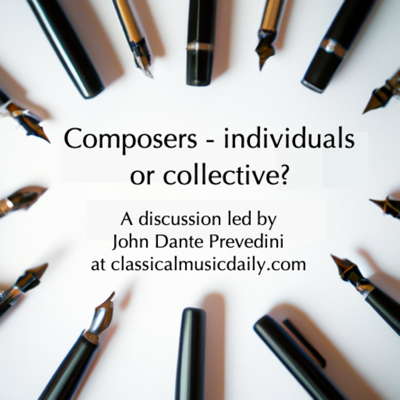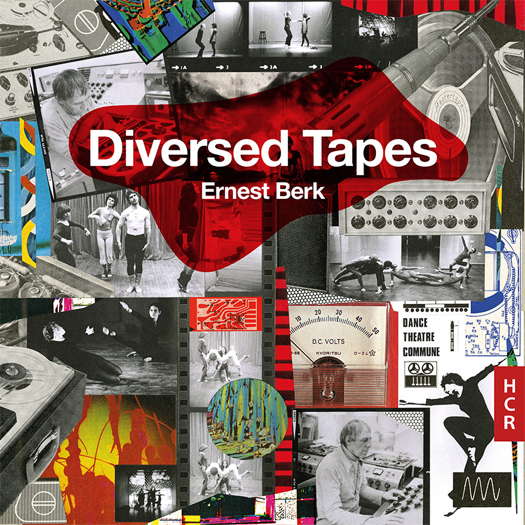- David McVicar
- Markus Stenz
- Rachmaninov
- Imbi Tarum
- Tchaikovsky: 1812 Overture
- Meridian Sinfonia
- Sweelinck: Mein Junges Leben Hat Ein End
- Dina Duisen
 SPONSORED: An Integral Part - Lindsey Wallis looks forward to the Canadian Music Centre's tribute concert to composer Roberta Stephen.
SPONSORED: An Integral Part - Lindsey Wallis looks forward to the Canadian Music Centre's tribute concert to composer Roberta Stephen.
All sponsored features >>
 DISCUSSION: John Dante Prevedini leads a discussion about Composers, individuals or collective?, including contributions from David Arditti, Halida Dinova, Robert McCarney and Jane Stanley.
DISCUSSION: John Dante Prevedini leads a discussion about Composers, individuals or collective?, including contributions from David Arditti, Halida Dinova, Robert McCarney and Jane Stanley.

The Tyranny of Consensus
JOHN DANTE PREVEDINI discovers a missing chapter in the history of electronic music in England
'... increased subtlety and variety of techniques employed ...'
Diversed Tapes is the recent release from Huddersfield Contemporary Records of a compilation of eighteen single-movement compositions for fixed media by the German-born UK-based composer Ernest Berk (1909-1993). The two-hour long album is available both as a two-CD set and in digital format, and the booklet contains a biographical essay by Ian Helliwell, Sam Gillies and Monty Adkins on Berk's life and compositional process as it relates to the electronic works presented on this release.
To quote the booklet essay:
Ernest Berk was one of the most prolific composers of electronic music in England and yet his work has remained almost completely unknown to the wider public.
This, the essay authors conclude, is because:
the emerging narratives around electronic music history have tended to concentrate on the existence of novel electronic instruments or institutional centres of composition and their figureheads [...] at the expense of individuals who were not part of these touchstones.
Specifically, the authors state, Berk explored:
both microphone-orientated musique concrète and oscillator-based electronic music - techniques which still represented an ideological divide in France and Germany.
Furthermore, he did so while rejecting:
the commercially driven cycle of discarding and replacing still useful equipment.
Thus, history has largely obscured Berk's integral role in helping shape the early evolution of electronic music in England. The purpose of this release is therefore to serve as an introductory overview of his output and to advocate for its rightful place within that history.
The pieces featured on the album represent a varied, though small, sample of Berk's substantial output in the medium. These works, composed between 1957 and 1984, are presented out of chronological order on the release, and only a minority of them are given specific dates in the booklet notes. Listeners can nonetheless still come away with a sense of how Berk's compositional voice gradually evolved under the unusual circumstances of his own self-imposed creative conditions.
By limiting himself to the same equipment over the course of nearly thirty years, for example, he enabled himself to cultivate a rare mastery of his particular instrument - a setup of 'tape recorders, tone generators, filters, and modulators' according to the liner notes. Indeed, one can hear the increased subtlety and variety of techniques employed in his palette as the decades progress.
At the same time, by freely mixing sounds from both acoustic and synthetic sources, he developed an uncommonly rich sonic vocabulary for his medium, even if doing so did violate the aforementioned divisions in electronic music culture which England would nonetheless gradually inherit from the continent. In any case, the result is Berk's audible cultivation of a highly individual electronic compositional practice that celebrates the conceptually and structurally novel, not just the sonically novel.
For example, in Jacobs Ladder, unpitched material contrasts with material that is not only pitched but also organized in traditional Western equal temperament. In this piece, sounds reminiscent of wind fade in and out from chromatic-scale passages apparently recorded on a celesta in the mid-low register. Both of these sonic events, in turn, fade into and out of silence.
Listen — Ernest Berk: Jacobs Ladder
(HCR34 CD1 track 1, 0:00-0:30) ℗ 2024 Huddersfield Contemporary Records :
A second example can be found in Totentantz (von Basel). This piece begins with an aggressive pulsation of low, distorted piano-like passages interspersed with rapidly pulsating thunderous passages, sounds reminiscent of birds chirping and slow sustained tone passages interspersed with silence. Layers of slow and rapid melodic content then gradually give way to a march-like unpitched percussion cadence that seems to lead the listener in a kind of procession to conclude the piece. This 'dance of death', as the title suggests, is thus complex and deceptive in its resulting symbolic treatment of the subject matter.
Listen — Ernest Berk: Totentantz (von Basel)
(HCR34 CD1 track 2, 0:00-0:30) ℗ 2024 Huddersfield Contemporary Records :
To give a final example, Synchrome has the effect of an extended mass of pulsating brass-like sounds with reverberation and electronically processed drumming. Notably, there are many elements of Western sonic practice perceptibly used here in quite a traditional way, particularly in Berk's utilization of rhythm, harmony and timbre. In this case, these almost seem to go against the ethos of electronic composition that would gradually develop and form the basis of much current practice in the field. (For instance, young composers are often discouraged from using electronic equipment to directly evoke sounds from the acoustical world, as this contradicts their duty to always use electronics to 'free' sound from the limitations of that world.)
Listen — Ernest Berk: Synchrome
(HCR34 CD2 track 4, 0:00-0:30) ℗ 2024 Huddersfield Contemporary Records :
The remaining pieces on this album - too many to analyze here in similar depth - likewise demonstrate Berk's highly sophisticated and idiosyncratic compositional voice in other ways.
One of the most unfortunate - and yet common - paradoxes in the development of musical traditions is what happens when a culture achieves a coherent identity by suppressing the imagination of possibilities within its own artistic media. It is worth emphasizing here that I do not mean discouraging certain artistic ideas as impractical or tasteless on reasoned grounds. I mean, rather, the normalized dismissal of untested artistic ideas as 'impossible' to begin with on the basis of their mere absence from the relevant preexisting canon. Oftentimes the motivation behind such collective shifts can be, admittedly, quite constructive. On the more positive end of the spectrum this can surface as the simple practice of honoring specific artistic traditions and selected 'masters' within them.
In the conservatory system, for instance, if a composition student wishes to compose a string quartet, they are usually met with the following response from mentors:
What string quartets have you studied?
The unarticulated implication here is that, while it is technically necessary just to know that a string quartet is an extended composition for two violins, viola and cello in its standard instrumentation, it is culturally necessary to know much more. One must know the works of Haydn, Beethoven, Bartók and others to understand the stylistic lineages and shared audience expectations that inform the perceived significance of new compositions within that string quartet culture, etc.
On the more negative end of the spectrum, however, we have the conditions that produced the famously hostile reception to Beethoven in his own lifetime upon completing his late string quartets. We also have the corresponding response to Bartók upon completing his quartets a century afterward, including even the reaction of the young Charles Rosen, who would later admit in his Modernist Music lecture that Bartók's work on first hearing had made him feel 'seasick'. And yet, in both cases, what was once supposedly 'impossible' repertoire has ultimately become not only acceptable to the evolving string quartet culture but, moreover, foundational to it. Such is the possible pattern which I also see in the story of Ernest Berk told through the present album.
Diversed Tapes paints the portrait of a composer who laid bare many powers of electronic music to a generation of colleagues, even as a culture of prestigious rhetoric convinced those colleagues to doubt their senses on the matter. Such a tyranny of consensus is liable to arise in any place where culture-defining norms are being vigorously formed or reformed. At its best, a consensus of esteem can help to preserve many of the legacies and traditions that anchor an artistic culture's identity and keep it coherent and visible. At its worst, however, it can stifle the very diversity of individual efforts that artistic cultures ultimately depend on for innovation and adaptive survival - much like how curtailing genetic diversity is harmful for the survival of any biological species.
In conclusion, I find this release to be an essential document for students of electronic music and its history in England, as well as a necessary effort in completing a missing chapter in that history.
Copyright © 24 August 2024
John Dante Prevedini,
Connecticut, USA



